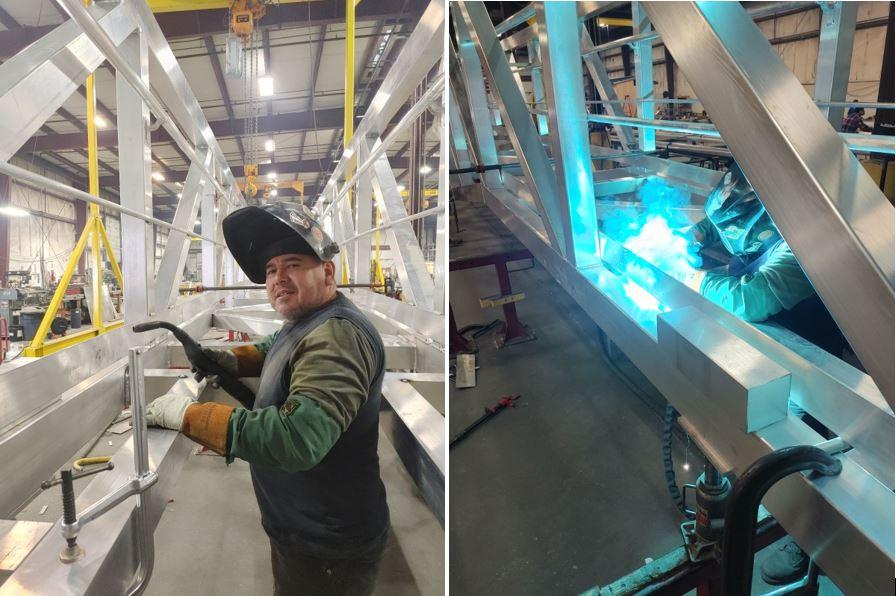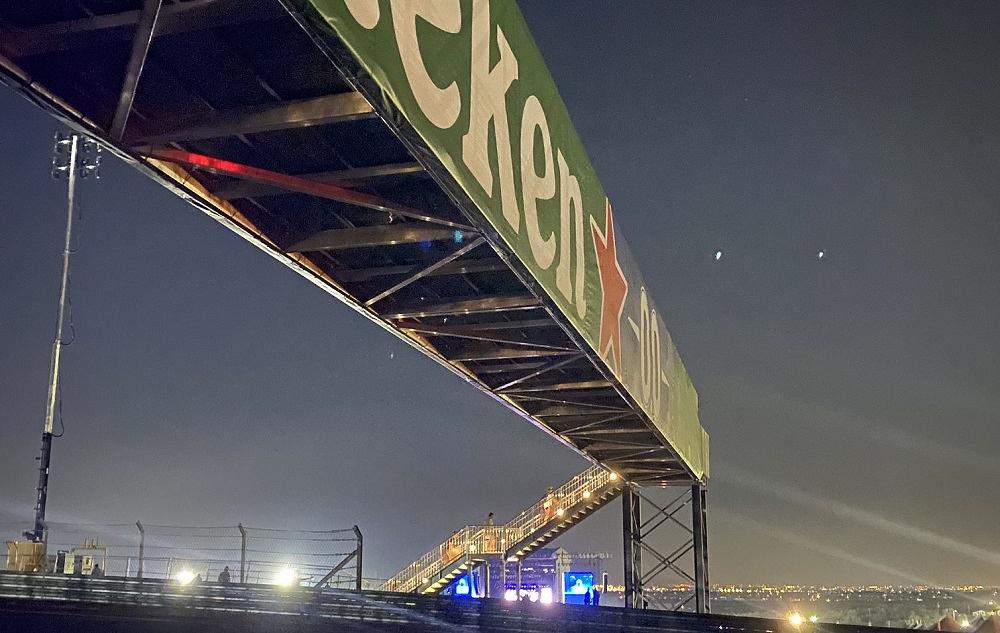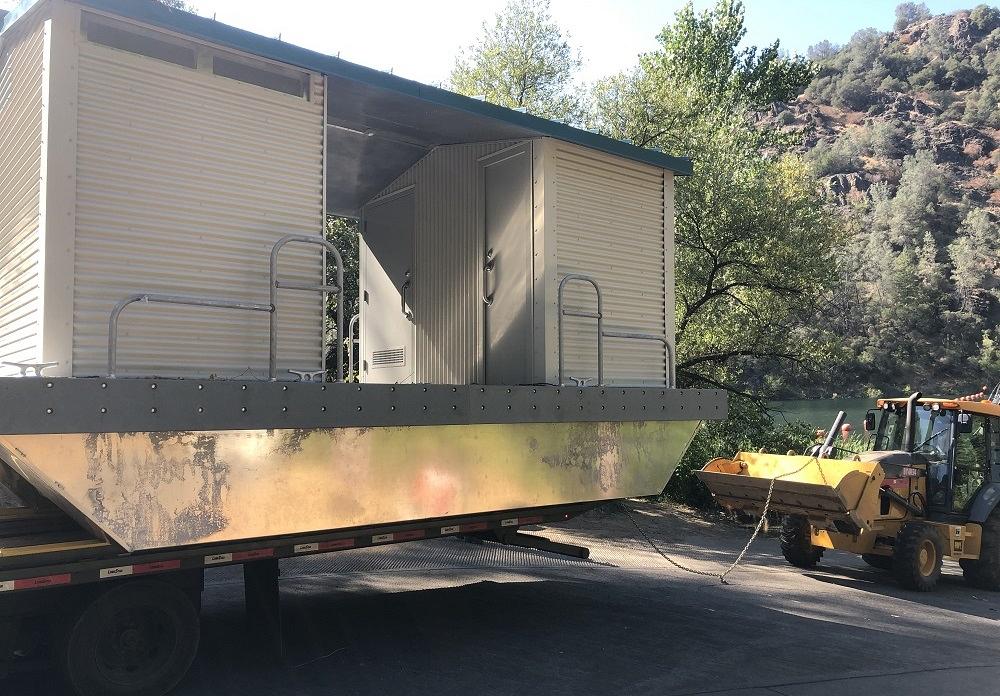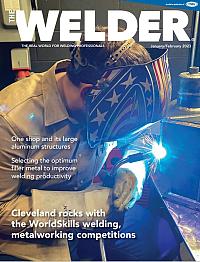Editor
- FMA
- The Fabricator
- FABTECH
- Canadian Metalworking
Categories
- Additive Manufacturing
- Aluminum Welding
- Arc Welding
- Assembly and Joining
- Automation and Robotics
- Bending and Forming
- Consumables
- Cutting and Weld Prep
- Electric Vehicles
- En Español
- Finishing
- Hydroforming
- Laser Cutting
- Laser Welding
- Machining
- Manufacturing Software
- Materials Handling
- Metals/Materials
- Oxyfuel Cutting
- Plasma Cutting
- Power Tools
- Punching and Other Holemaking
- Roll Forming
- Safety
- Sawing
- Shearing
- Shop Management
- Testing and Measuring
- Tube and Pipe Fabrication
- Tube and Pipe Production
- Waterjet Cutting
Industry Directory
Webcasts
Podcasts
FAB 40
Advertise
Subscribe
Account Login
Search
Washington metal shop goes big with aluminum structures
Welding aluminum and huge structures is no problem for Pacific Northwest fabricator
- By Rafael Guerrero
- February 1, 2023
- Article
- Aluminum Welding

Washington-based Topper Industries estimates its team of welders have a combined 100 to 120 years of experience under the hood. Images: Topper Industries
If you’re into Formula One racing, you probably know of the Circuit of the Americas, the Austin, Texas-based racetrack that is home to the United States Grand Prix.
The sport’s recent growth in popularity saw ticket demand for the last few U.S. Grand Prix races swell, leading to an increase in attendance at the racetrack. For the circuit to accommodate hundreds of thousands of spectators over race weekend, additions were required, including bridges.
For the 2021 race, the Circuit of the Americas installed a 160-ft.-long bridge on Turn 10—an aluminum structure fabricated by Woodland, Wash.-based Topper Industries.
“It was critical to the tenants that we get it delivered [by that date]. If I remember correctly, they opened up the [circuit] to another 100,000 attendees,” said Kim Rongey, purchasing and logistics manager at Topper Industries.
The Pacific Northwest structure manufacturer specializes primarily in aluminum structures, including bridges, gangways, catwalks, floating docks, and floating restrooms. With each project, its team of about 40—including about two dozen in general labor, including welding—gets to showcase years of experience and expertise in aluminum metal fabrication.
“There's not very many companies in the country that manufacture, can design, and engineer … these kinds of large aluminum structures,” added sales manager Bruce Abraham. “And so, a lot of times people come to us.”
Bridges, Gangways, and Floating Restrooms
The large aluminum structures that Topper Industries builds run the gamut when it comes to size. It could be something as small as a gangplank for a residential customer or it could be something much bigger, like a large bridge that’s eventually shipped to Alaska.
The business originated as a floating dock manufacturer in 1977. Eventually, Topper transitioned into making bigger and more varied projects.
Abraham said the gangways they built into the early 2000s were “pretty small” at around 40 to 60 ft. However, regulation changes made it possible for Topper to go bigger, and soon 80-ft.-long gangways became commonplace. The structures became wider, too, with widths of 10 ft. The Topper team noted one gangway they fabricated that is now in Oakland, Calif., is 20 ft. wide.
Fabrication time can range from two to four weeks once drawings and proposals get approved. Abraham said it can take about three to six months for a customer to go through the entire process of a proposal, drawings, fabrication, shipping, and installation.

The Pacific Northwest-based shop specializes in aluminum structures, ranging from residential gangways and docks to massive bridges. Shown is a 160-ft.-long bridge for the Circuit of the Americas in Austin, Texas, and the Formula One United States Grand Prix.
Among the structures Topper is known for are floating restrooms—that is, amenities that will float on a body of water.
“It takes quite a bit of knowledge to put those together,” Abraham said.
Topper has built floating restrooms for about 20 years. In that time, it has fine-tuned these structures and improved plumbing, sanitation, electrical, and project efficiency.
Floating restrooms typically are 11-ft.-wide, 20-ft.-long structures with heights of around 12 ft.; some can be bigger depending on the order. While most restroom customers tend to be state, federal, or parks and recreation agencies, some are individual customers looking for “functional luxury.” These restrooms could include more storage or feature upscale bathroom counters.
“They can have showers, they can have laundry,” Abraham said. “They can be pretty special units.”
Rongey said: “Basically, what we produce is always an architectural finish. It's not like doing structural. It has to be smooth and beautiful because it's a part of the building that is immediately visible to the public.
“The attention to detail and the skill level is vitally important,” she added.
Working With Aluminum
Topper employees estimate around 90% of what they work on is aluminum.
For the many structures that often will be on or near bodies of water, aluminum provides numerous benefits, they said. The metal is typically resistant to corrosion and does not rust, for instance. The material’s light weight, meanwhile, makes it easier to handle during the fabrication process and installations.
“When we get a bridge that's 120 ft. long, instead of weighing 30,000 to 50,000 lbs. [with steel], it weighs 13,000 to 14,000 lbs. [with aluminum],” Abraham said. “It's just much easier to handle.”

Topper primarily uses aluminum because the nonferrous metal’s unique properties prove advantageous for structures installed on or near bodies of water.
“We design everything in-house. Everything we make is custom designed and engineered,” added Topper Industries Owner Elias Angell. “We do a variety of industrial and heavy commercial products that have to sustain the Alaskan winters, the Alaskan tide fluctuations.”
Angell continued, “A lot of our gangways and bridges see a lot of movement—up, down, right, left, as you can imagine—with the environment they're in, whether it's heavy Alaska winters or the Pacific [conditions] around Portland, Seattle, and down to California with the pretty intense tide loads and wave loads.”
However, aluminum’s unique properties can scare off and challenge welders. Like others, the company has struggled finding its next welders. Topper has made an effort to boost local interest in the trades through partnerships with area schools and higher education institutions.
Add in the fact the Woodland area comprises more production welding than aluminum fabrication and it makes for slim pickings for aluminum welders.
“I can tell you it is much harder to find aluminum welders here than it is for steel welders, and that's really always been the case,” Rongey said.
“It was a challenge to find aluminum welders before COVID. Now, it is almost impossible,” she added.
Nonetheless, the team of welders at Topper have roughly 100 to 120 years of experience under the hood. Some have welded for 30-plus years.
“Aluminum being such a unique material to weld, the talent pool is limited,” said Operations Manager Doug Brusoe, who first started welding in the 1980s. “You have to really look hard and deep to find good, qualified welders and people who can be trained.
“A lot of our customers are repeat customers,” Abraham added. “They come back to us because they know that we have the experience and the reputation to put out a quality product.”
Aluminum Welding: What Should Welders Know?
When asked what welders should know about working with aluminum, Brusoe provided three tips.

One of the aluminum structures Topper has built over the years are floating restrooms. These structures tend to be for state, federal, or parks and recreation agencies, although some are built for private customers.
The first: “You have to have your parts cleaned very properly. Whether it’s wiping down with acetone, wiping with a wire brush or Scotchgard if the oxidation is heavy. The preparation must be clean with no contaminants.”
His second tip addressed the welding environment.
“It has to be at least 50 degrees or warmer in the environment you are welding in,” Brusoe said. If it isn’t warm enough, you risk “cracking and/or start throwing moisture into your puddle, which will give you nitrogen contamination.”
Brusoe’s last tip? Always have heat management in mind.
“You don’t have to burn it as hot as you possibly can. You just need enough to weld and make the connection,” he said. “A lot of people like to run it way too hot. You can actually affect the mechanical properties of the base material, along with the chemical properties, by welding too hot.
“Welding aluminum is a different ballgame than welding steel, just for its mechanical properties,” he added. “With steel, your heat-affected zone is very narrow, within 3 in. of the weld puddle at the most. Aluminum is like a glass of water. The whole thing gets hot, so you accumulate [heat] throughout the entire part.”
About the Author

Rafael Guerrero
2135 Point Blvd.
Elgin, IL 60123
(815)-227-8242
Rafael Guerrero. was named editor of The Welder in April 2022. He spent nine years as a journalist in newspapers in the Midwest and Pacific Northwest, covering topics and communities in central Illinois, Washington, and the Chicago area.
About the Publication
subscribe now

The Welder, formerly known as Practical Welding Today, is a showcase of the real people who make the products we use and work with every day. This magazine has served the welding community in North America well for more than 20 years.
start your free subscription- Stay connected from anywhere

Easily access valuable industry resources now with full access to the digital edition of The Fabricator.

Easily access valuable industry resources now with full access to the digital edition of The Welder.

Easily access valuable industry resources now with full access to the digital edition of The Tube and Pipe Journal.
- Podcasting
- Podcast:
- The Fabricator Podcast
- Published:
- 04/16/2024
- Running Time:
- 63:29
In this episode of The Fabricator Podcast, Caleb Chamberlain, co-founder and CEO of OSH Cut, discusses his company’s...
- Trending Articles
Sheffield Forgemasters makes global leap in welding technology

Welding student from Utah to represent the U.S. at WorldSkills 2024

Lincoln Electric announces executive appointments

Engine-driven welding machines include integrated air compressors

ESAB unveils Texas facility renovation

- Industry Events
16th Annual Safety Conference
- April 30 - May 1, 2024
- Elgin,
Pipe and Tube Conference
- May 21 - 22, 2024
- Omaha, NE
World-Class Roll Forming Workshop
- June 5 - 6, 2024
- Louisville, KY
Advanced Laser Application Workshop
- June 25 - 27, 2024
- Novi, MI


























